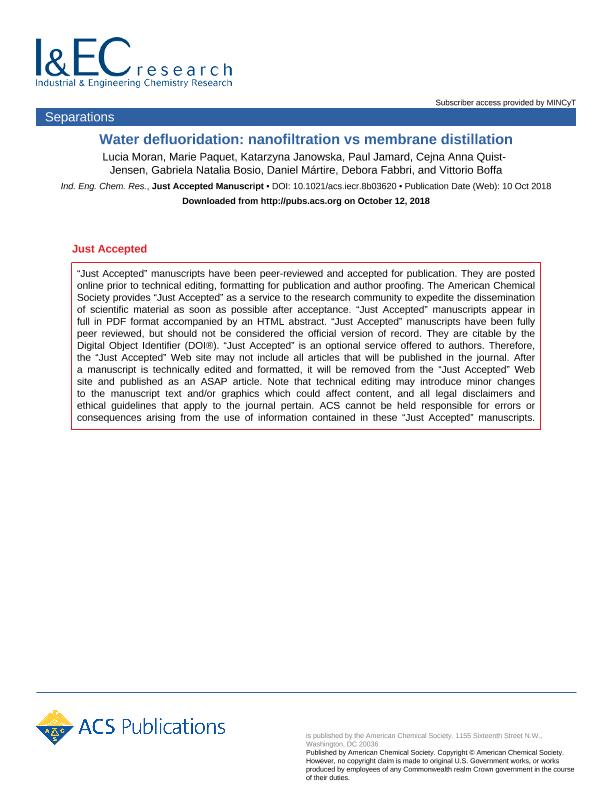Mostrar el registro sencillo del ítem
dc.contributor.author
Moran Ayala, Lucia Isabel

dc.contributor.author
Paquet, Marie
dc.contributor.author
Janowska, Katarzyna
dc.contributor.author
Jamard, Paul
dc.contributor.author
Quist Jensen, Cejna A.
dc.contributor.author
Bosio, Gabriela Natalia

dc.contributor.author
Martire, Daniel Osvaldo

dc.contributor.author
Fabbri, Debora
dc.contributor.author
Boffa, Vittorio
dc.date.available
2020-03-19T18:54:40Z
dc.date.issued
2018-10
dc.identifier.citation
Moran Ayala, Lucia Isabel; Paquet, Marie; Janowska, Katarzyna; Jamard, Paul; Quist Jensen, Cejna A.; et al.; Water Defluoridation: Nanofiltration vs Membrane Distillation; American Chemical Society; Industrial & Engineering Chemical Research; 57; 43; 10-2018; 14740-14748
dc.identifier.issn
0888-5885
dc.identifier.uri
http://hdl.handle.net/11336/100328
dc.description.abstract
Nowadays, fluoride contamination of drinking water is a major problem for various countries, because high concentrations of fluoride pose a risk of dental and skeletal fluorosis. Over past years, membrane nanofiltration (NF) has been proposed as convenient defluoridation technology. However, NF cannot be applied to water systems with high fluoride concentration, and the disposal of the membrane concentrate remains an issue. In this work, we compared a commercial polyester NF membrane and a polypropylene hollow-fiber membrane distillation (MD) module for their ability to remove fluoride ions from water in the presence of hardness ions and organic fouling agents. The NF membrane can offer more than 10 times higher water productivity than MD, under realistic gradients of temperature and pressure, respectively. Despite that, after reaching a concentration factor of about 3, fouling and scaling caused the flux to drop to about 80% with respect to its initial value. Moreover, F- retention decreased from 90% to below 80%, thus providing a permeate of scarce quality. MD was operated in the direct-contact mode on a polypropylene hollow-fiber membrane, which was charged with a hot feed flow (average T = 58 °C) on one side and a cooled (20 °C) permeate flow of distilled water on the other side. The concentration of fluoride ions in the permeate was always below the detection limit of our electrode (0.2 ppm), regardless of the fluoride concentration in the feed. Moreover, the MD module showed higher resistance to fouling and scaling than NF, and CaF2 crystals were recovered from the MD concentrate after cooling. These results suggest that the synergic combination of the two techniques might be beneficial for the purification of fluoride-contaminated water systems: MD can be used to further concentrate the NF retentate, thus producing high-purity water and recovering CaF2 crystals.
dc.format
application/pdf
dc.language.iso
eng
dc.publisher
American Chemical Society

dc.rights
info:eu-repo/semantics/openAccess
dc.rights.uri
https://creativecommons.org/licenses/by-nc-sa/2.5/ar/
dc.subject
Membrana de Destilacion
dc.subject.classification
Otras Ingeniería Química

dc.subject.classification
Ingeniería Química

dc.subject.classification
INGENIERÍAS Y TECNOLOGÍAS

dc.title
Water Defluoridation: Nanofiltration vs Membrane Distillation
dc.type
info:eu-repo/semantics/article
dc.type
info:ar-repo/semantics/artículo
dc.type
info:eu-repo/semantics/publishedVersion
dc.date.updated
2020-03-16T14:01:46Z
dc.journal.volume
57
dc.journal.number
43
dc.journal.pagination
14740-14748
dc.journal.pais
Estados Unidos

dc.description.fil
Fil: Moran Ayala, Lucia Isabel. Consejo Nacional de Investigaciones Científicas y Técnicas. Centro Científico Tecnológico Conicet - La Plata. Instituto de Investigaciones Fisicoquímicas Teóricas y Aplicadas. Universidad Nacional de La Plata. Facultad de Ciencias Exactas. Instituto de Investigaciones Fisicoquímicas Teóricas y Aplicadas; Argentina
dc.description.fil
Fil: Paquet, Marie. University of Aalborg; Dinamarca
dc.description.fil
Fil: Janowska, Katarzyna. University of Aalborg; Dinamarca
dc.description.fil
Fil: Jamard, Paul. University of Aalborg; Dinamarca
dc.description.fil
Fil: Quist Jensen, Cejna A.. University of Aalborg; Dinamarca
dc.description.fil
Fil: Bosio, Gabriela Natalia. Consejo Nacional de Investigaciones Científicas y Técnicas. Centro Científico Tecnológico Conicet - La Plata. Instituto de Investigaciones Fisicoquímicas Teóricas y Aplicadas. Universidad Nacional de La Plata. Facultad de Ciencias Exactas. Instituto de Investigaciones Fisicoquímicas Teóricas y Aplicadas; Argentina
dc.description.fil
Fil: Martire, Daniel Osvaldo. Consejo Nacional de Investigaciones Científicas y Técnicas. Centro Científico Tecnológico Conicet - La Plata. Instituto de Investigaciones Fisicoquímicas Teóricas y Aplicadas. Universidad Nacional de La Plata. Facultad de Ciencias Exactas. Instituto de Investigaciones Fisicoquímicas Teóricas y Aplicadas; Argentina
dc.description.fil
Fil: Fabbri, Debora. Università di Torino; Italia
dc.description.fil
Fil: Boffa, Vittorio. University of Aalborg; Dinamarca
dc.journal.title
Industrial & Engineering Chemical Research

dc.relation.alternativeid
info:eu-repo/semantics/altIdentifier/urn/https://pubs.acs.org/doi/10.1021/acs.iecr.8b03620
dc.relation.alternativeid
info:eu-repo/semantics/altIdentifier/doi/http://dx.doi.org/10.1021/acs.iecr.8b03620
Archivos asociados
